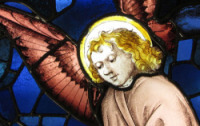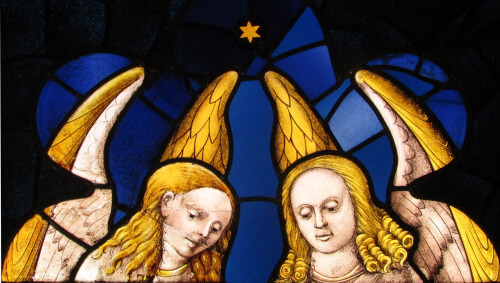
For many years now, the Friends of the Abbey Museum have been busily raising funds for the conservation of two of the most significant medieval stained glass windows in the Museum collection. These were wonderful medieval stained glass windows originally from Winchester Cathedral. At times we wondered if we would ever raise the required funds. We held many fundraising events included our annual Medieval Christmas– Gregorian Chanting nights and also Walk for Winchester, in which many of us walked from Bribie Island to the Abbey in a “pilgrimage” supported by sponsors and raising some much needed dollars. So there was great excitement when we were finally successful in an application to the Regional Arts Development Fund for the balance required so that the work could begin.
It is amazing to think that it was just over a year ago (17th December 2013) that the very fragile windows were removed. There were many times when our hearts were in our mouths as the conservators Gerry Cummins and Jill Stehn gently eased the windows from the clutches of rock hard putty which had kept them in place for some 40 years. The work was painstakingly slow, but this was just the prelude of what was to come.

Kings Glazier create Winchester Windows
Why, you may ask? Well, this Winchester Cathedral glass is arguably the most significant collection of medieval fragments in Australia. They come from three great windows installed in about 1492 in the Lady Chapel at Winchester. It is believed that the major panels featuring angel heads were the work of the internationally renowned King’s Glazier, William Neve. They feature two themes — the Nativity of Christ, represented by a manager and stable scene with a night time sky full of golden stars, golden haired angels and a highly significant head of the Angel Gabriel, and the Bethlehem star overhead, as well as a theme based on the Book of Revelation with fragments featuring one of the beasts of the Gospel author, St Mark.
The windows have major international historical significance because of their age (1490’s), and as part of an internationally significant building (Winchester Cathedral), which is one of the world’s greatest examples of Norman architecture. They also have important historical connotations through their association with the royal house of Tudor; especially Queen Elizabeth of York and the birthplace of Prince Arthur.
It was important that these windows, even though they were very fragmentary, be preserved in the very best way. There were many times throughout the last year that we have agonised over the glass. Firstly its extreme fragility was a major concern; some of the 600 year old glass paint was flaking off at the slightest touch. So before even the old lead work had been removed the longevity of the glass was in question.
It should be noted that the windows had undergone a previous restoration when the Abbey Church was being constructed. Sadly some unsightly pieces of modern glass had been inserted.
How to reconstruct the windows so that they more clearly presented the original design of the panels was discussed at length. It was extremely exciting when Gerry Cummins identified that the original stained glass artist had used the same cartoon to draw each of the angel heads. This was a stunning revelation and played a significant part in the outcome of project. It was also fun to see how the artist had personalised each of the angel heads giving one ringlets, another long wavy hair and one had a slightly elongated face.

Angels from on High
In the end it was agreed to use the surviving fragments to recreate panels to represent the original headers as closely as possible to Neve’s design. The two Abbey Church windows now include three pairs of winged angels, a magnificent single angel know as the Angel Gabriel and a winged lion, symbol of the evangelist St Mark.
The Abbey Museum offers tours of the medieval stained glass in the Abbey Church on Tuesdays and Thursdays at 11.00 am or for groups by appointment. Book your visit to the Abbey Museum and plan your visit so that you have the opportunity to see our wonderful stained class collection.

